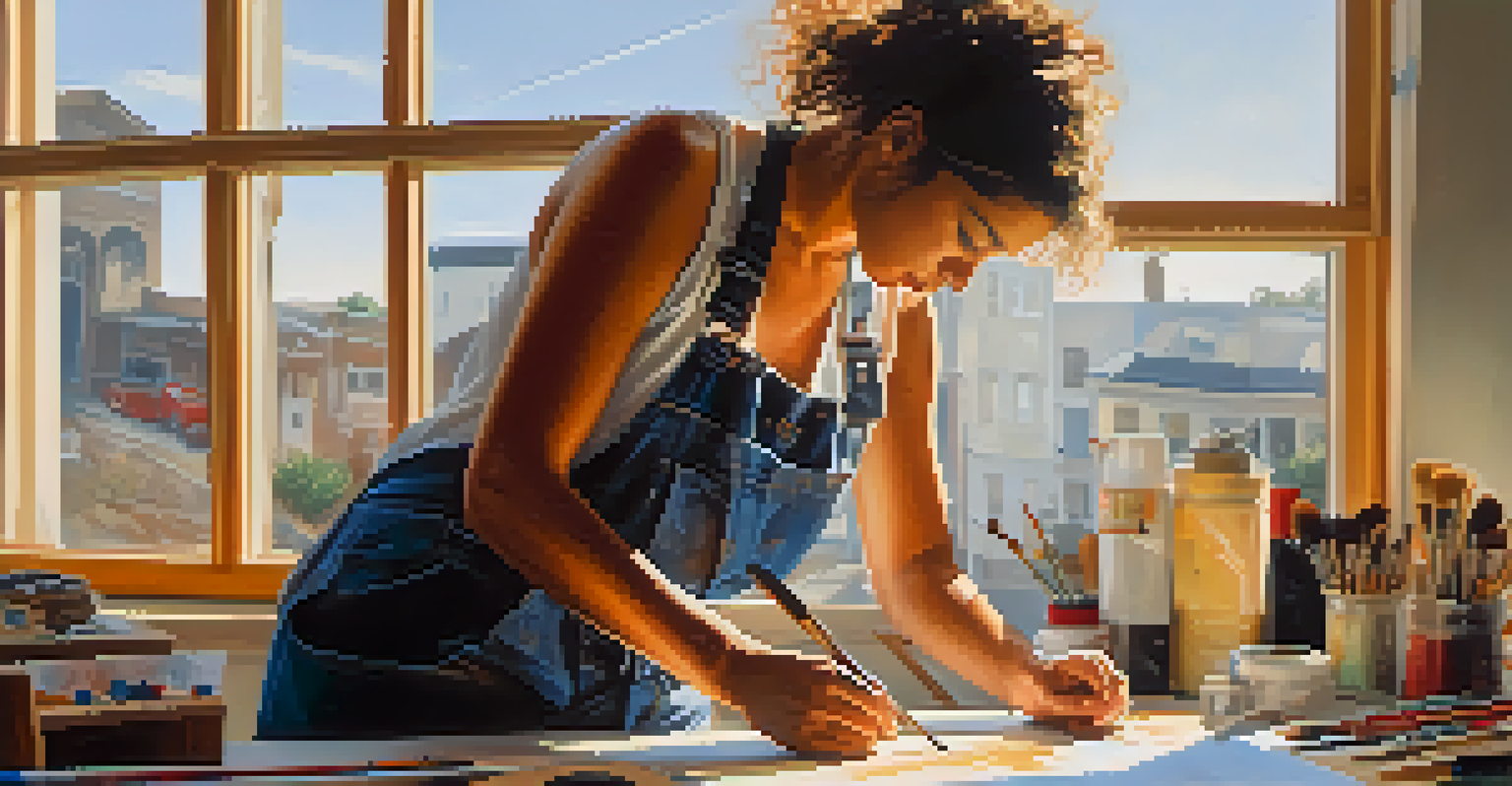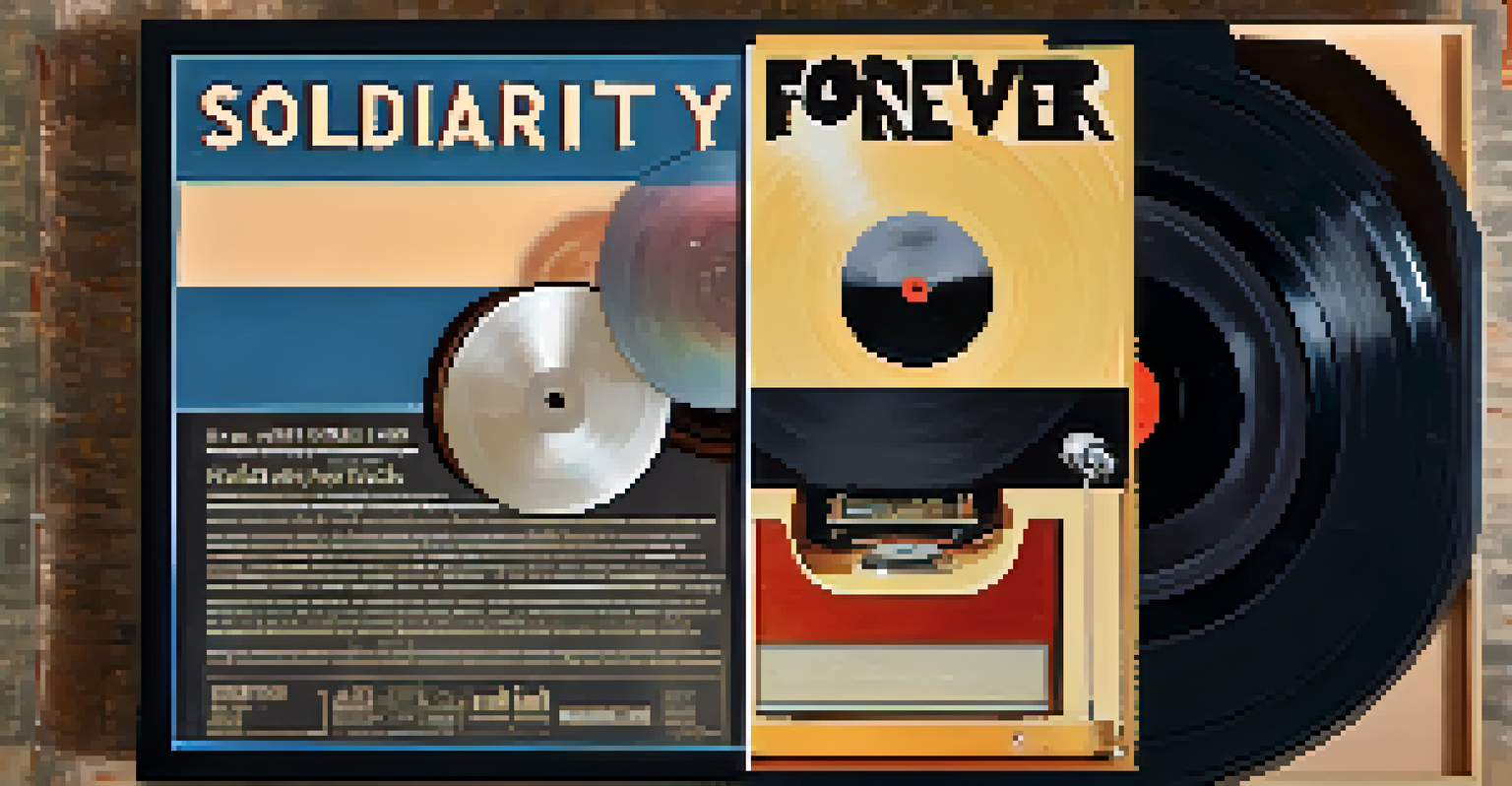Art and Labor Rights: Creative Expressions of Workers’ Struggles

The Intersection of Art and Labor Rights
Art and labor rights have a rich history intertwined through social movements. From songs that sing the struggles of workers to murals depicting their fight for fair wages, creative expressions have served as powerful tools for change. These artistic endeavors highlight the experiences of workers, transforming personal stories into universal narratives.
Art is not a mirror held up to society, but a hammer with which to shape it.
When artists draw inspiration from labor movements, they create a dialogue that resonates with both workers and the broader public. This connection amplifies the voices of those often marginalized in society. By showcasing the plights and triumphs of workers, art elevates their struggles into the national consciousness.
Moreover, art often captures the spirit of the times, reflecting societal values and challenges. It can motivate action and foster solidarity among workers, reminding them that they are not alone in their fight. This symbiotic relationship between art and activism underscores the importance of creative expressions in the ongoing struggle for labor rights.
Historical Context: Art as a Tool for Change
Throughout history, art has played a pivotal role in labor movements. For example, during the Industrial Revolution, artists depicted the harsh realities faced by factory workers, raising awareness about their conditions. This era gave rise to powerful visual art, literature, and music that echoed the demands for justice and equity.

The labor movement of the early 20th century saw the emergence of politically charged art, with artists using their platforms to advocate for change. From the WPA’s murals in the United States to the propaganda posters in various countries, art became a medium for promoting labor rights and social justice. These works not only documented struggles but also inspired collective action.
Art Amplifies Labor Voices
Art serves as a powerful tool to elevate the struggles of workers, transforming personal narratives into universal stories that resonate with the public.
As we look back, it's clear that art functions as a historical record of workers' struggles. It captures emotions, experiences, and the essence of movements that shaped labor rights. By preserving these narratives, art ensures that the lessons learned are not forgotten and can guide future generations.
Modern Movements: Art in Today’s Labor Struggles
In today's world, art continues to play a crucial role in labor rights movements. Contemporary artists are using various mediums—such as graffiti, digital art, and performance—to highlight ongoing issues like wage theft, worker exploitation, and unsafe working conditions. This modern expression reflects the urgency of current struggles and resonates with younger audiences.
The function of art is not a rarified, intellectual distillate; it is life, intensified, brilliant life.
Social media has transformed the way art reaches people, allowing for rapid sharing and widespread engagement. Hashtags paired with striking visuals can mobilize support for labor initiatives and amplify workers’ voices. This democratization of art fosters a sense of community and solidarity among those advocating for change.
As new generations of workers face challenges, artists are stepping up to create powerful narratives that reflect their realities. Whether through poignant posters or viral videos, these creative expressions remind us that the fight for labor rights is ongoing. They inspire action and remind us that art can be a catalyst for change.
Case Study: The Role of Music in Labor Rights
Music has long been a vital form of expression within labor movements, serving as an anthem for solidarity and resilience. Songs like 'Solidarity Forever' have become rallying cries, encapsulating the struggles and aspirations of workers. This powerful medium evokes emotions and builds community among those fighting for their rights.
Folk music, in particular, has been instrumental in narrating the stories of workers. Artists like Woody Guthrie and Pete Seeger used their platforms to share the experiences of laborers, making the struggles relatable to the public. Their songs often highlight themes of unity and perseverance, encouraging collective action.
Historical Impact of Art
Throughout history, art has documented and inspired labor movements, capturing the essence of workers' struggles and advocating for social justice.
In recent years, modern artists have also embraced this tradition, using genres like hip-hop and punk to address workers' issues. By infusing contemporary sounds with messages of resistance, these musicians keep the spirit of labor activism alive. Music continues to be a powerful vehicle for awareness and change, uniting generations in the fight for justice.
Visual Arts: Murals and Public Installations
Visual art, particularly murals, plays a significant role in the labor rights movement by transforming public spaces into platforms for advocacy. Murals depicting workers' struggles can be found in cities around the world, serving as a constant reminder of the ongoing fight for rights and dignity. These large-scale artworks not only beautify neighborhoods but also spark conversations about labor issues.
Public installations, like sculptures and interactive exhibits, further engage communities in dialogues about labor rights. They invite viewers to reflect on the historical and current challenges faced by workers. These artistic expressions often provoke thought and encourage action, making labor rights more visible in everyday life.
Moreover, visual arts can bridge cultural gaps, uniting diverse communities in shared struggles. When art reflects the collective experience of workers, it fosters a sense of belonging and empowerment. This connection through visual storytelling is essential in the ongoing fight for labor rights.
Literature: Writing as Resistance
Literature has long been a form of resistance, giving voice to the struggles of workers. Novels, poetry, and essays can capture the essence of labor movements, highlighting the injustices faced by workers and their fight for change. Through storytelling, writers create an emotional connection that fosters empathy and understanding.
Works like John Steinbeck's 'The Grapes of Wrath' and Upton Sinclair's 'The Jungle' have illustrated the harsh realities of labor in America, shedding light on the need for reform. These literary masterpieces not only document history but also inspire action, encouraging readers to reflect on their own roles in the fight for justice.
Modern Art and Labor Rights
Contemporary artists utilize various mediums to address current labor issues, fostering community solidarity and inspiring action through creative expression.
In contemporary literature, authors continue to explore themes of labor rights and social justice. By sharing personal narratives and experiences, they create a platform for dialogue and awareness. This literary activism is crucial in keeping the conversation about labor rights alive and engaging new audiences.
The Future of Art in Labor Rights Advocacy
As we look to the future, the role of art in labor rights advocacy is more important than ever. With ongoing challenges in the workforce—like gig economy issues and workplace discrimination—creative expressions will continue to be vital in raising awareness and promoting change. Artists will play a crucial role in shaping the narrative around labor rights.
Emerging technologies, such as virtual reality and augmented reality, offer new avenues for artistic expression and engagement. These innovative tools can create immersive experiences that highlight labor struggles and inspire action. By pushing the boundaries of traditional art forms, artists can captivate audiences in ways that resonate deeply.

Ultimately, the fusion of art and labor rights will continue to evolve. As artists adapt to new mediums and societal changes, they will remain at the forefront of advocating for justice. The power of creative expression will ensure that the voices of workers are heard and that their struggles are not forgotten.